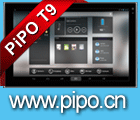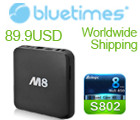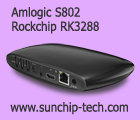Vensmile K1 Plus is Android TV Box powered by 64bit Amlogic S905 Quad-core ARM Cortex-A53 up to 2.0Ghz, based on Android 5.1.1 Lollipop, comes with HDMI2.0 it support 4K@60fps H.265, with 1GB RAM, 8G Flash, price can be around $45 for 500pcs bulk order, start shipping from middle November.
Distributors can contact Vensmile here:
Cherry Mo, Sales Manager
Skype: vissonsales015
cherry.mo@vissontech.com
Mobile: +86 18617132669 (works with Whatsapp/Wechat)
http://www.vissontech.com
http://www.vensmile.net
http://www.vsmart.en.alibaba.com
http://www.amazon.com/dp/B01795OJSW
http://www.aliexpress.com/store/product/Newest-Vensmile-K1-plus-Android-5-1-1-STB-Hybrid-Amlogic-S905-Quad-Core-1080p-4K/1755667_32513653135.html
$45 64bit Quad-core Amlogic S905 TV Box by Vensmile K1 Plus
GTEK P100 $15 IPX7 Waterproof Bluetooth Speaker Double 3 Watt RAW Speaker
GTEK P100 is a IPX7 waterproof Bluetooth speaker with full rubber shell, under 1 meter depth water over 30 minutes but still good sound.
With build-in 3000mAH battery, battery life up to 8 hours. with double 3 watts raw speaker diameter 40mm and super bass inside, Price at $15 for over 1000pcs bulk order.GTEK also produce other bluetooth speaker price from $2, they provide ODM/OEM service from MOQ 1000pcs.
You can contact GTEK here:
Shelly Ren, Sales Manager
Mobile:+86 133 0296 0513
info@gtekltd.com
http://www.gtekltd.com
Geniatech WiTV DVB-T2 ISBDT Watch Full HD TV on Tablet/Phone Anywhere You Like
Geniatech WiTV is a portable wireless TV Tuner connected your Android or IOS mobile phone or tablet to watch free-to-air Digital TV via Geniatech customized App. It comes with a changeable and rechargeable NOKIA Phone battery, battery life up to 2.5 hour to cover a football match. The reach of WiTV is around 5-7 meters, it allows you watch the TV anywhere at home or on the go. It also support up to 2 devices(tablet/phone) use at the same time.
WiTV already start shipping with DVB-T2 version which works in most Europe countries and ISDBT version for most South American Countries. ATSC version will come soon.
Distributors can contact Geniatech at:
http://geniatech.com
sales@geniatech.com
Keynote: ARM Cortex-A35, ARMv8-M, Cryptocell, mbed connector announced by ARM CTO Mike Muller
ARM CTO Mike Muller announces ARM Cortex-A35 to power the future of Low to Mid-range Smartphones and is also good for Wearables and Embedded, 20% higher performance and 10% lower power consumption compared to ARM Cortex-A7. ARMv8-M which is the next generation architecture for ARM Cortex-M microcontroller devices shipping into Billions of devices per year. Mike Muller talks about ARM’s big work on security for IoT and to connect IoT with the Cloud, ARM launches the mbed connector service and shows mbed OS 3.0.
Qualcomm Open Source on Dragonboard 410c
Qualcomm talks about their Open Source Software Strategy, getting upstream support in the Linux Kernel for the Qualcomm based Development Boards like the Dragonboard 410c. Supporting Linux, Android, supporting Freedreno the Open Source GPU driver for Qualcomm processors, working towards support of OpenCL and more.
Rockchip Light Biz OS Convertible Dual-display on RK3288 for $155 by KNC
KNC shows their first Android tablet/convertible running Rockchip Light Biz OS, a modified Android for productivity and work, running on Rockchip RK3288 Quad-core ARM Cortex-A17 with Mali-T764 GPU, the modified Android 5.1 OS with a windows-like GUI, with Multi-tasking and Microsoft Office or any other Android app supported. With an external Keyboard and mouse connected, Light Biz OS turns the KNC D1 tablet into a productive Androd Laptop, here showing Light Biz OS’s second display multi-tasking. The KNC D10 features 10.1’’ 1920*1200 IPS display, 2GB RAM, 16GB Flash or 32GB optional, 2MP front Camera, 5MP back camera, with 8000mAh Li-battery, battery life up to 8 hours. Bulk Price at around $155.
Distributors can contact KNC here:
hfhe@inhuasoft.cn
Mobile:+86 186 8218 6006
http://www.huaruian.com
http://knc-smart.com
Merlin IntelliSense Coherence Kit, Virtual Realty rhythmic breathing trainer
Merlin IntelliSense Coherence Kit is a virtual reality-based rhythmic breathing trainer that also measures Autonomic Nervous System (ANS). Applying the right HRV calculations at the right times gives insight into ANS. It’s like accessing body’s command center. IntelliSense measures ANS and teaches to gain control over heart rate variability, thereby helping to maximize performance, boost recovery, and optimize stress levels. You can read more about Merlin Coherence Kit at http://merlin-digital.com/intellisense-coherence-kit.html
Distributors can contact Merlin here (please let them know you watched this video):
sales@merlin-me.com
http://merlin-digital.com
$30 Lossless Audio player, with Bluetooth, FM, TFT/Touch Screen Optional by HOTT
The HOTT A503 is the HiFi Bluetooth MP3 player with FM radio supported, build-in Micro-SD card maximum from 4GB to 32GB. Hott Lossless audio player is priced at $30 for 1K bulk. Upper cost at $1 for HOTT A504 with a LED display. HOTT A502 is a lossless audio player, features with a 2.8’’ touch screen, support FLAC, APE, support TF card maximum to 64GB. best price at $32 for MOQ 1K. There will be $2 less if you choose HOTT A501 without Touch screen.
You can contact HOTT for more information:(Please let them know you watched this video)
Richard, Sales Manager
Sales01@hott.net.cn
Mobile:+86 158 2043 5882
Vensmile R8 $50 64bit Octa-core RK3368 TV Box with 4K@60fps H265 and Kodi15.2
Vensmile R8 is an Android TV Box powered by 64bit Rockchip RK3368 Octa-core ARM Cortex-A53, runs Android 5.1 Lollipop and comes pre-installed with Kodi15.2, HDMI2.0, plays back H265 4K@60fps. With Gigabit Ethernet, 2.4G WiFi and Bluetooth 4.0, 2GB RAM and 8GB Flash, sample price at $55, price can be around or below $50 for over 100pcs bulk order.
Distributors can contact Vensmile here:
Cherry Mo, Sales Manager
Skype: vissonsales015
cherry.mo@vissontech.com
Mobile: +86 18617132669 (works with Whatsapp/Wechat)
http://www.vissontech.com
http://www.vensmile.net
http://www.vsmart.en.alibaba.com
http://www.amazon.com/VENSMILE-R8
http://www.aliexpress.com/store/product/VENSMILE-R8
Tena $27 RK3128 TV Box PCB, $200 80-lumen Smart projector
Tena shows their portable TI DLP 80-lumen smart projector powered by Rockchip RK3188 Quad-Core ARM Cortex-A9, 1GB RAM, 8GB Flash, Sample price at $200. Tena also makes PCB boards for TV Boxes of many other brands based on Rockchip and Actions SOCs directly. TV Box PCBs can price at around $27 for RK3128 Quad-Core ARM Cortex A7 with 1GB RAM and 8GB Flash or Actions ATM7039 Quad-Core ARM Cortex A9.
Distributors can contact Tena here:
Anna, Sales Manager
anna@sztena.com
Mobile: +86 185 6666 1905
Shirley, Sales Manger
Shirley@sztena.com
Mobile: +86 135 5475 5360
$35 64bit AmLogic S905 TV Box from Unuiga with 4K@60fps HEVC on Android 5.1.1
Unuiga shows their Amlogic S905 Android TV Box, based on AmLogic S905 Quad-Core 64bit ARM Cortex-A53 and five-core Mali-450 GPU, it runs Lollipop Android 5.1.1, decodes 4K H.265 60fps with HDMI 2.0. Unuiga can customize the firmware for ODM/OEM customers, current firmware showcases Unuiga’s own Android app market with full TV box apps easily controlled by remote control or air mouse, Unuiga Live-TV Channels with hundreds free TV channels in different languages. The price is $35 for 1GB RAM and 8GB Flash.
Distributors can contact Unuiga here:
Steven Ching
Managing Director
Mobile: +8618038133940 (works with WhatsApp)
Phone: +86-755-86110143
Skype: stevenching1976
Email: steven@unuiga.com
http://www.unuiga.com
Rockchip Light Biz OS official video
Rockchip’s Light Biz OS is Android 5.1 modified and with a Launcher optimized for Productivity, Multi-tasking, for Android Laptops, Android Desktops, Android Projectors, any Android device for doing work.
$9.99 drones and $19.5 Drone with Camera by CoolerStuff
Cooler stuff shows their drones at different price levels, $9.99(in bulk) Mini drones with RC, $19.5 with built-in camera, $16 drone with 4 wheels (car/drone combo), also a very affordable remote live stream camera drone and more.
Distributors can contact CoolerStuff here:
market@coolerstuff.net
Mobile:+86 13825822066
Velev shows $1.4 USB LED light, $4.1 USB Bluetooth Speaker and $1.6 USB Fan
Velev shows their mini USB gadgets including a Mini USB LED Light at $1.4 (in bulk), Mini Breeze USB Fan $1.6 (in bulk), Mini USB Bluetooth Speaker for $4.1 (in bulk). They also shows their universal smartphone holder, desktop smartphone holder, Bluetooth Selfie shutter, all products of Velev is based on original-design and private-tooling.
Distributors can contact Velev here: (let them know if you watched this video)
David Duan
davidduan@velev.com.cn
Mobile:+86 13631595975
Rockchip Light Biz OS for Android Laptops/Desktops, UI for productivity on RK3288 and RK3368
Rockchip has been working on multi-window Android for the last 2-3 years, this is their latest version, Rockchip calls it Light Biz OS, it is based on Android 5.1 with all of the millions of Android apps supported as in any other Android. This is Rockchip’s attempt at giving Android a Windows-like feeling, with Microsoft Office and other office apps supported, with smooth Multi-Tasking and Multi-Windows funtions, Rockchip’s Dual display feature can output different apps to the secondary display, digital-pen features are also supported for notes and drawing. Rockchip deeply develops Light Biz OS fpor their RK3288 Quad-core 32bit ARM Cortex-A17 and their RK3688 Octa-core 64bit ARM Cortex-A53 platform for tablet, Mini PC, TV Box, Android Laptop/convertible and more.
Meidi RK3188 Tablet with 100-lumen Projector
Meidi shows TI DLP 100-lumen smart Android projectors based on Rockchip RK3188 Quad-core ARM Cortex-A9, 1GB RAM, 8GB Flash, Bulk price at $200 for 100pcs minimum quantity order. It runs Android 4.4, supports Miracast, Airplay, DLNA. They also show a 3D projector with 500-lumen brightness, also based on Rockchip RK3188 with 1GB RAM, 8GB Flash, priced at $450 for 200pcs bulk order.
Fiona Ma, Sales Manger,
sales@szmdi.com
Skype: fiona_ma
$37 iPhone 6S clone, $25 cheapest Android phone, $44-49 Quad-core SC7731/MT6580, $81 MT6735 LTE
These are some of the latest cheap Smartphones in China based on the MediaTek MT6580, MT6735, Spreadtrum SC7731 and SC7715. Here’s a $37 iPhone 6S clone with a removable back case to support removable battery, 3G dual-sim, it runs a 5″ qHD display on a Spreadtrum SC7731 Quad-core ARM Cortex-A7 (I say A5 in the video by mistake, it’s actually A7). 512MB RAM and 4GB Flash but expandable by MicroSD slot. One of the world’s cheapest Android phones is the $25 SC7715 single-core ARM Cortex-A7 phone with 3.5″ display. A little higher specced are Huawei Mate 7 and Huawei P8 clones at $44 on Spreadtrum SC7731 and for $49 you get 5.5″ qHD and 5″ HD phones on the MediaTek MT6580 Quad-core ARM Cortex-A7. For LTE I found a 5.5″ qHD IPS on 64bit MediaTek MT6735 Quad-core ARM Cortex-A53 with 1GB RAM and 8GB Flash. Sorry I didn’t prepare this video well I say many wrong things about the CPUs, prices, Android versions etc check the annotations I try to fix it there.
Reeman Robot on RK3288 Android with Artificial Intelligence, 10″ touchscreen, sensors
Reeman is a Robotics startup in Shenzhen making a $500 Robot for kids to play, to video-chat with their parents at work, for parents to video-monitor their kids at any time remotely, for kids to learn and play. Reeman Robot has advanced features based on the Rockchip RK3288 Quad-core ARM Cortex-A17 with ARM Mali-T760 GPU, it also has 3 micro-controllers, motors, sonar and infrared sensors, 3D camera sensors (to map and recognize where it is in rooms and spaces!), stereo microphones (to know where sound is coming from!), built-in speakers, camera, a 10.1″ capacitive touch-screen, it’s able to go back to the charger to charge itself automatically! An ex-employee from IBM is developing an artificial intelligence system for it to learn and react intelligently to an unlimited number of situations, questions and sentences in Chinese. Reeman has a team of 20 engineers now working hard to ship this robot on the Chinese market at $500 (2999rmb) in the first quarter of next year!
Reeman is very interested to find a partner to help develop English-language AI system with English voice-recognition, apps and educational/gaming content so this robot can be sold outside of China also! (hello Google/Alphabet? Can you make them a Robotics APK for Android with APIs for all sensors etc?) Interested partners, developers, distributors can contact Reeman below:
Jerry Gao, CEO
Jerry.Gao@reeman.cn
Mobile: +86 18902468056
Phone: +86 75586239429
http://www.reeman.cn/?_l=en
96Boards IoT Starter Kit with UART and Arduino-compatible Sensors Platform
Grant Likely of Linaro introduces the http://96Boards.org IoT Starter Kit with retail price aimed at around $45 which includes the 96Boards UART also available at http://www.seeedstudio.com/depot/96Boards-UART-p-2525.html and the Arduino-compatible 96Boards Sensors adapter board.
Pipo scooter and Pipo X9 Intel Mini PC with 8.9″ touchscreen, Win10 + Android Dual OS
Ben Lai, CEO of Pipo, shows off Pipo self-balance scooter and introduces his full products line including latest Intel Mini PC stick (with a fan), Intel Mini PC (with displays and without), Intel tablet and Intel laptop. The New Pipo X9 powered by Quad-Core Intel Baytrail Z3736F, 2G RAM, 32GB ROM, featured with 8.9’’ 1920*1200 Multi-touch screen, installed Windows 10 + Android 4.4 Dual OS, with WiFi 802.11b/g/n and Bluetooth4.0, 4* USB 2.0 port.It can work as a tablet or table mini PC.
Distributors can contact PiPo here:.
Ben Lai, CEO
Ben.lai@pipo.com.cn



